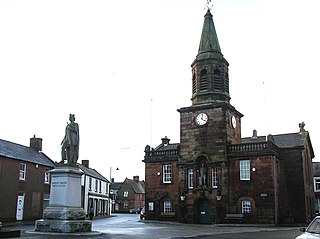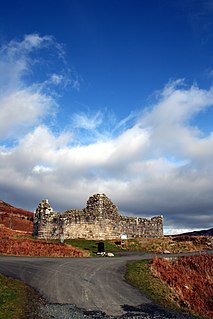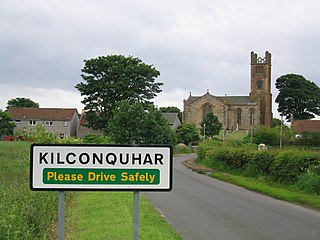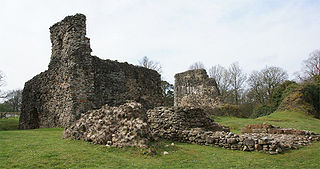Citations
Coordinates: 55°07′33″N3°26′28″W / 55.1257°N 3.4410°W / 55.1257; -3.4410
| | This article about a Scottish building or structure is a stub. You can help Wikipedia by expanding it. |
Lochmaben Castle was a 12th-century castle on the spit of land between Loch Kirk and Loch Castle, in Lochmaben, Scotland. [1]
The motte and bailey castle was built in the 12th century by the de Brus family, Lords of Annandale. The castle became the main seat of the de Brus family after Annan Castle was partially destroyed during a flood in the 12th century. The castle was captured in 1298 by King Edward I of England. King Edward began to make improvements to the castle, before deciding to build "New" Lochmaben Castle as a replacement in the 14th century, to the south-east.
Coordinates: 55°07′33″N3°26′28″W / 55.1257°N 3.4410°W

Robert I, popularly known as Robert the Bruce, was King of Scots from 1306 to his death in 1329. One of the most renowned warriors of his generation, Robert eventually led Scotland during the First War of Scottish Independence against England. He fought successfully during his reign to regain Scotland's place as an independent kingdom and is now revered in Scotland as a national hero.
Inchmurrin is an island in Loch Lomond in Scotland. It is the largest fresh water island in the British Isles.

Lochmaben is a small town and civil parish in Scotland, and site of a castle. It lies 4 miles (6 km) west of Lockerbie, in Dumfries and Galloway. By the 12th century the Bruce family had become the local landowners and, in the 14th century, Edward I rebuilt Lochmaben Castle. It was subsequently taken by Archibald Douglas, 3rd Earl of Douglas in 1384/5 and was abandoned in the early 17th century. The town itself became a Royal Burgh in 1447.
Robert de Brus, 6th Lord of Annandale, jure uxoris Earl of Carrick (1252–1292), Lord of Hartness, Writtle and Hatfield Broad Oak, was a cross-border lord, and participant of the Second Barons' War, Ninth Crusade, Welsh Wars, and First War of Scottish Independence, as well as father to the future king of Scotland Robert the Bruce.

Robert V de Brus, 5th Lord of Annandale, was a feudal lord, justice and constable of Scotland and England, a regent of Scotland, and a competitor for the Scottish throne in 1290/92 in the Great Cause. He is commonly known as "Robert the Competitor". His grandson Robert the Bruce eventually became King of Scots.

Loch Doon Castle was a castle that was located on an island within Loch Doon, Scotland.

Clan Bruce is a Lowlands Scottish clan. It was a Royal House in the 14th century, producing two kings of Scotland, and a disputed High King of Ireland, Edward Bruce.

Tibbers Castle is a motte-and-bailey castle overlooking a ford across the River Nith in Dumfries and Galloway, Scotland. To the east is the village of Carronbridge and to the north west is a 16th-century country house, Drumlanrig Castle.
Robert II de Brus, le Meschin was a 12th-century Norman noble and 2nd Lord of Annandale. He was the son, perhaps the second son, of Robert de Brus, 1st Lord of Annandale.

Kilconquhar is a village and parish in Fife in Scotland. It includes the small hamlet of Barnyards. It is bounded by the parishes of Elie, Ceres, Cameron, St Monans, Carnbee, Newburn and Largo. It is approximately 9 miles from north to south. Much of the land is agricultural or wooded. The village itself is situated inland, north of Kilconquhar Loch. Also in the civil parish are Colinsburgh and Largoward, the latter since 1860 being a separate ecclesiastical parish.

Finlaggan is a historic site on Eilean Mòr in Loch Finlaggan. The Loch, the island, and Finlaggan Castle lie on Islay, around two kilometres to the northwest of Ballygrant.

Lochmaben Castle is a ruined castle in the town of Lochmaben, the feudal Lordship of Annandale, and the united county of Dumfries and Galloway. It was built by Edward I in the 14th century replacing an earlier motte and bailey castle, and later rebuilt during the reign of James IV of Scotland. The earlier motte-and-bailey castle was built south of the current castle in c. 1160 by the Bruce family, Lords of Annandale.

Tarbert Castle is located on the southern shore of East Loch Tarbert, at Tarbert, Argyll, Scotland, at the north end of Kintyre. Tarbert Castle was a strategic royal stronghold during the Middle Ages and one of three castles at Tarbert. The castle overlooks the harbour and although pre 14th century in construction, the tower dates back to 1494 and the visit of James IV to the Western Highlands.

The Annandale Way is a 90-kilometre (56 mi) hiking trail in Scotland, which is officially designated by NatureScot as one of Scotland's Great Trails. It follows the valley of the River Annan from its source in the Moffat Hills to the sea in the Solway Firth south of the town of Annan. The route, which was established on 12 September 2009, has been designed to be traversable in four to five days as a continuous walk but it also offers several day-walks. Overnight stops can be arranged in small market towns and villages along the route such as Moffat, Johnstonebridge, Lochmaben, Lockerbie, or Annan. The route has been developed by Sulwath Connections and local communities, with the support of local estates and farmers, to help promote Annandale as a new area for walking. Its trailheads are near the Devil's Beef Tub in the Moffat Hills and on the Solway Firth just south of Annan, in Newbie.
Dundee Castle was a castle in Dundee, Scotland, destroyed by Robert the Bruce in 1313.
Dumfries Castle was a royal castle that was located in Dumfries, Scotland. It was sited by the River Nith, in the area now known as Castledykes Park.
Wigtown Castle was a royal castle that was located on the banks of the River Bladnoch, south of Wigtown in Dumfries and Galloway, Scotland.
Annan Castle, was a castle that was located on the banks of the River Annan, in Annan, Scotland.
Sir Christopher Seton (1278–1306), also known as Christopher de Seton, was a 13th-century noble, who held lands in England and Scotland. He was a supporter of Robert the Bruce and obtained Robert's sister's hand in marriage. Present during the killing of John Comyn, Lord of Badenoch at Greyfriars Church, Dumfries, he also killed Sir Robert Comyn, who had rushed to Badenoch's aid. Seton was captured at Loch Doon Castle and executed at Dumfries in 1306.
The English invasion of Scotland of 1300 was a military campaign undertaken by Edward I of England to continue gains from the 1298 invasion, in retaliation of the Scots recapture of Stirling Castle in 1299 and the revolt in Annandale, Nithsdale and Galloway against English rule.